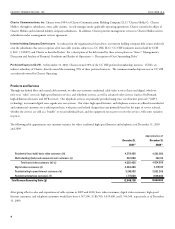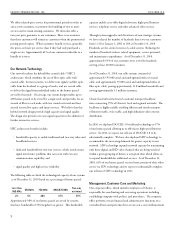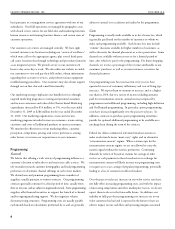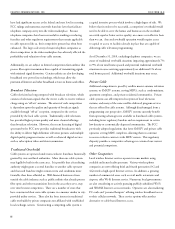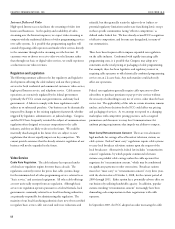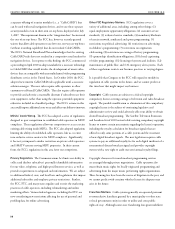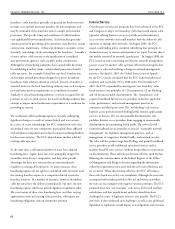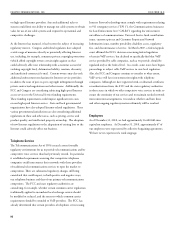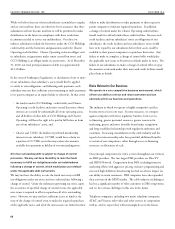Charter 2010 Annual Report Download - page 25
Download and view the complete annual report
Please find page 25 of the 2010 Charter annual report below. You can navigate through the pages in the report by either clicking on the pages listed below, or by using the keyword search tool below to find specific information within the annual report.
Internet Delivered Video
High-speed Internet access facilitates the streaming of video into
homes and businesses. As the quality and availability of video
streaming over the Internet improves, we expect video streaming to
compete with the traditional delivery of video programming services
over cable systems. It is possible that programming suppliers will
consider bypassing cable operators and market their services directly
to the consumer through video streaming over the Internet. If
customers were to choose to receive video over the Internet rather
than through our basic or digital video services, we could experience
a reduction in our video revenues.
e following summary addresses the key regulatory and legislative
developments affecting the cable industry and our three primary
services for both residential and commercial customers: video service,
high-speed Internet service, and telephone service. Cable system
operations are extensively regulated by the federal government
(primarily the FCC), certain state governments, and many local
governments. A failure to comply with these regulations could
subject us to substantial penalties. Our business can be dramatically
impacted by changes to the existing regulatory framework, whether
triggered by legislative, administrative, or judicial rulings. Congress
and the FCC have frequently revisited the subject of communications
regulation often designed to increase competition to the cable
industry, and they are likely to do so in the future. We could be
materially disadvantaged in the future if we are subject to new
regulations that do not equally impact our key competitors. We
cannot provide assurance that the already extensive regulation of our
business will not be expanded in the future.
Cable Rate Regulation. e cable industry has operated under
a federal rate regulation regime for more than a decade. e
regulations currently restrict the prices that cable systems charge
for the minimum level of video programming service, referred to as
“basic service,” and associated equipment. All other cable offerings
are now universally exempt from rate regulation. Although basic
service rate regulation operates pursuant to a federal formula, local
governments, commonly referred to as local franchising authorities,
are primarily responsible for administering this regulation. e
majority of our local franchising authorities have never been certified
to regulate basic service cable rates (and order rate reductions and
refunds), but they generally retain the right to do so (subject to
potential regulatory limitations under state franchising laws), except
in those specific communities facing “effective competition,” as
defined under federal law. We have already secured FCC recognition
of effective competition, and become rate deregulated, in many of
our communities.
ere have been frequent calls to impose expanded rate regulation
on the cable industry. Confronted with rapidly increasing cable
programming costs, it is possible that Congress may adopt new
constraints on the retail pricing or packaging of cable programming.
For example, there has been legislative and regulatory interest in
requiring cable operators to offer historically combined programming
services on an à la carte basis. Any such mandate could adversely
affect our operations.
Federal rate regulations generally require cable operators to allow
subscribers to purchase premium or pay-per-view services without
the necessity of subscribing to any tier of service, other than the basic
service tier. e applicability of this rule in certain situations remains
unclear, and adverse decisions by the FCC could affect our pricing
and packaging of services. As we attempt to respond to a changing
marketplace with competitive pricing practices, such as targeted
promotions and discounts, we may face Communications Act
uniform pricing requirements that impede our ability to compete.
Must Carry/Retransmission Consent. ere are two alternative
legal methods for carriage of local broadcast television stations on
cable systems. Federal “must carry” regulations require cable systems
to carry local broadcast television stations upon the request of the
local broadcaster. Alternatively, federal law includes “retransmission
consent” regulations, by which popular commercial television
stations can prohibit cable carriage unless the cable operator first
negotiates for “retransmission consent,” which may be conditioned
on significant payments or other concessions. Broadcast stations
must elect “must carry” or “retransmission consent” every three years,
with the election date of October 1, 2008, for the current period of
2009 through 2011. Either option has a potentially adverse effect on
our business by utilizing bandwidth capacity. In addition, popular
stations invoking “retransmission consent” increasingly have been
demanding cash compensation in their negotiations with cable
operators.
In September 2007, the FCC adopted an order increasing the cable




